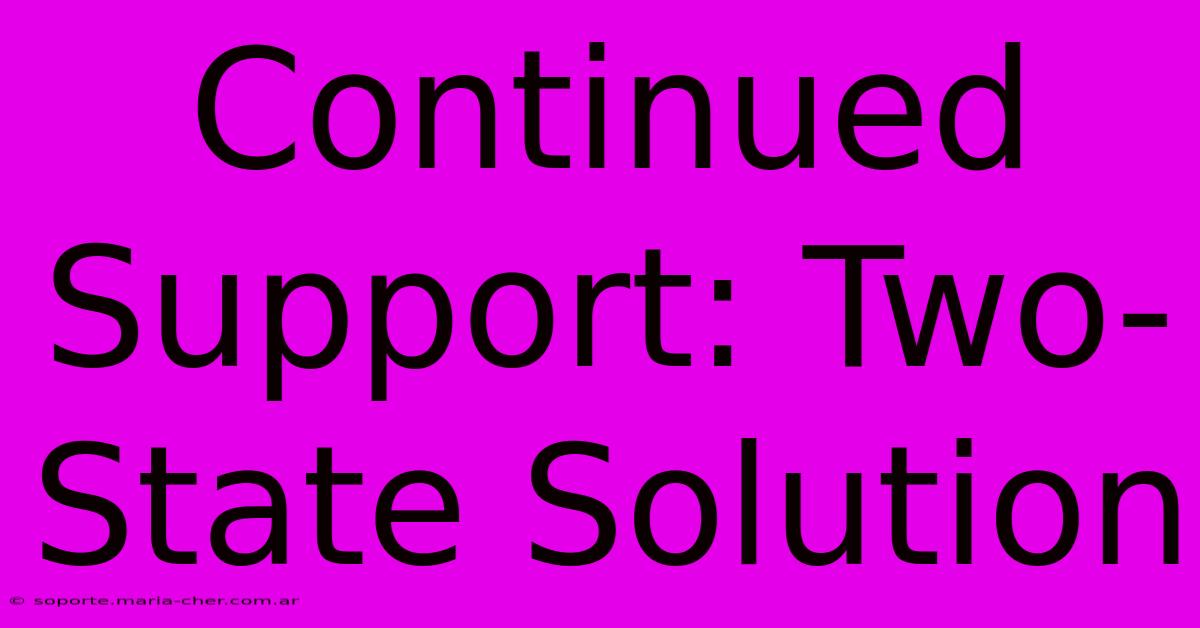Continued Support: Two-State Solution

Table of Contents
Continued Support: The Two-State Solution – A Path to Lasting Peace?
The Israeli-Palestinian conflict remains one of the world's most intractable challenges. For decades, the two-state solution, envisioning two independent states – one Israeli and one Palestinian – has been presented as the most viable path towards a lasting peace. However, continued support for this solution faces significant hurdles and requires a nuanced understanding of the complexities involved. This article explores the ongoing challenges and potential pathways forward for achieving a two-state solution.
The Core Principles of the Two-State Solution
At its heart, the two-state solution rests on several key principles:
- Mutual recognition: Both Israel and a future Palestinian state would formally recognize each other's existence and right to exist within secure and internationally recognized borders.
- Land for peace: Israel would cede significant portions of the occupied Palestinian territories, including the West Bank and Gaza Strip, in exchange for peace and security guarantees.
- Jerusalem: The status of Jerusalem, a city sacred to both Israelis and Palestinians, would need to be resolved through negotiations, possibly involving shared sovereignty or a divided city.
- Refugee issue: The fate of Palestinian refugees displaced during the 1948 Arab-Israeli war remains a highly contentious issue, requiring a just and equitable solution that respects the rights of all parties involved.
- Security arrangements: Mechanisms for ensuring the security of both states would be crucial, addressing concerns about terrorism and border control.
Obstacles to Continued Support
Despite its widespread endorsement, the two-state solution confronts significant obstacles:
Settlement Expansion: The continued expansion of Israeli settlements in the West Bank erodes the viability of a contiguous Palestinian state. This expansion is seen by many as a deliberate attempt to undermine the possibility of a two-state solution.
Political Polarization: Deep-seated mistrust and political polarization on both sides hinder meaningful negotiations. Extremist groups on both sides actively work against any compromise, making it challenging to find common ground.
Gaza Strip's Situation: The blockade of Gaza and the ongoing humanitarian crisis significantly impact the prospects for a viable Palestinian state. The situation in Gaza severely restricts the movement and economic opportunities of the Palestinian population.
Lack of International Pressure: The international community, while often voicing support for the two-state solution, has often lacked the political will to exert sufficient pressure on both sides to make significant compromises.
Pathways to Continued Support and Success
Reviving support for the two-state solution requires a multi-pronged approach:
Renewed International Engagement: Stronger international leadership is needed to facilitate negotiations and enforce agreements. This includes targeted sanctions against those who obstruct the peace process.
Addressing Settlement Expansion: A halt to settlement expansion is crucial for creating a sense of trust and demonstrating a commitment to the two-state solution. Existing settlements present significant logistical and political hurdles to forming a contiguous Palestinian state.
Economic Development in Palestine: Investing in the Palestinian economy is essential for building a viable and prosperous state. This would involve substantial international aid and investment in infrastructure, education, and job creation.
Confidence-Building Measures: Small-scale initiatives to build trust between Israelis and Palestinians can pave the way for more substantial progress. This could include joint projects in areas like water management or environmental protection.
Conclusion: A Hopeful Outlook?
While the obstacles to achieving a two-state solution are substantial, abandoning the pursuit of peace is not an option. Continued support, coupled with a renewed commitment from all parties involved, along with consistent pressure from the international community, is crucial. Only through sustained diplomatic efforts, addressing the core issues with creative solutions, and fostering genuine reconciliation can the dream of a lasting peace in the Middle East, based on the two-state solution, become a reality. The alternative—a single state—presents even greater challenges and risks for both Israelis and Palestinians. Therefore, sustaining the momentum towards a two-state solution remains a priority for regional stability and lasting peace.

Thank you for visiting our website wich cover about Continued Support: Two-State Solution. We hope the information provided has been useful to you. Feel free to contact us if you have any questions or need further assistance. See you next time and dont miss to bookmark.
Featured Posts
-
Trumps Gaza Plan Disaster Warning
Feb 05, 2025
-
Elevate Your Email Signature Get A Wise Stamp Pro Discount Today
Feb 05, 2025
-
Fantastic Four Join The Mcu
Feb 05, 2025
-
Transform Your Nails In Minutes The Dip Powder Magic You Ve Been Waiting For
Feb 05, 2025
-
Sorry But Its Not Just An Apology We Re Ready To Listen And Act
Feb 05, 2025
